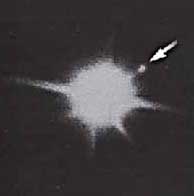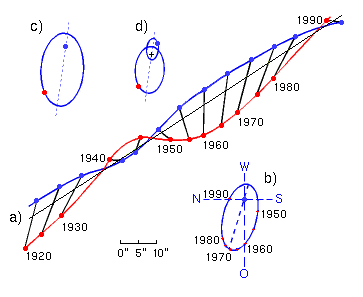The Sirius System
[1] - [2] - [3] - [4] - [5]In 1718, Edmund Halley determined that Sirius and a number of other stars were moving. We now know that all stars are in orbit round the galaxy. Each star has its own proper motion - Sirius was one of the first stars to have its proper motion detected.
In 1844, Bessel noticed that Sirius wobbled as it moved along its course. He predicted that it had an unseen companion.
 In 1862, Alvan Clark detected the unseen companion.
In 1862, Alvan Clark detected the unseen companion.
Spectroscopy revealed that Sirius B had a very high temperature. Its low luminosity idicated that it must be about the size of Earth. Because Sirius B is part of a binary system with a fifty year orbital period, its mass was calculated to be equivalents to that of the Sun. Sirius B was found to be a representative of a newly disovered class of stars, extraordinarily dense white dwarfs.
In 1935, Chandrasekhar explained how sun-sized stars would degenerate to white dwarfs once fusion ceased.

a) The paths of Sirius A and Sirius B
b) The binary pair take 50 years to complete an orbit
c) From the view point of the brighter star, Sirius B follows a highly eliptical orbit
d) The pair actually orbit round their common centre of mass